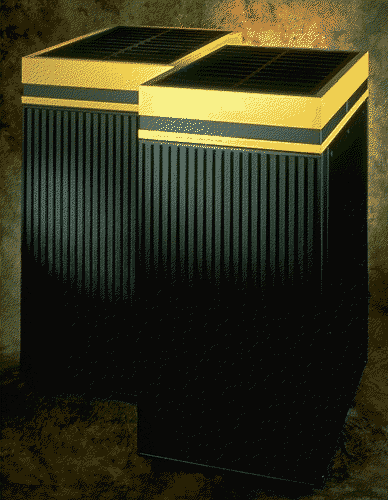
Convex Computer was a Richardson, Texas based manufacturer of vector "minisupercomputers", founded in 1982. Convex was the most successful of the minisuper vendors, but they too succumbed to the pressures of commoditization. Their "Exemplar" series was based on HP PA-RISC processor technology, and paved the way for Convex's acquisition by Hewlett-Packard in 1994.
The Exemplar family is still being sold by HP as of this writing. The proprietary "C-series" of vector processors are extinct, however, and represent a dead supercomputer architecture.
The Convex C machines took a Cray-like approach, a vector/parallel system with vector registers. As they were much more cost sensitive than Cray Research, however, Convex were less aggressive with chip technology and accepted a slower cycle time. They reduced the memory bandwidth available to each processor to the equivalent of one operand per cycle, as opposed to 2 or 3 for a Cray. To compensate, the vector registers were longer than those of a Cray, 128 64-bit elements as opposed to 64 elements for the Cray, and Convex invested heavily in automatic vectorization techniques.
The C1 was a uniprocessor vector machine that appeared in 1985. The C2 was a crossbar-intectonnected multiprocessor. scaling to 4 CPUs, that was launched in 1988. The C3 was announced in 1991, and had essentially the same architecture as the C2, albiet with a faster clock, and support for up to 8 CPUs. Memory bandwidth was becoming an increasing liability at this point, and two successor projects were undertaken in parallel. The C4 was an evolutionary enhancement of the GaAs vector/parallel design, while the Exemplar scapped the approach altogether in favor of "off-the-shelf" CPUs in a distributed shared memory configuration based on SCI.
The C1 was based on CMOS ASICs and was characterized at 20 MFLOPS peak for double precision computation, twice that for single precision. The C2 was an ECL implementation rated at 50 MFLOPS peak. The C3 and C4 migrated the same basic architecture to GaAs. A range of C3 CPUs were offered, claiming from 50 to 240 peak MFLOPS per CPU.
Convex systems ran a UNIX variant OS, called (imaginatively enough) ConvexOS, and were supplied with automatically parallelizing C and FORTRAN compilers.

A Convex C4600. See Johnathan Hardwick's CMU supercomputer photo archive for a higher-resolution version.